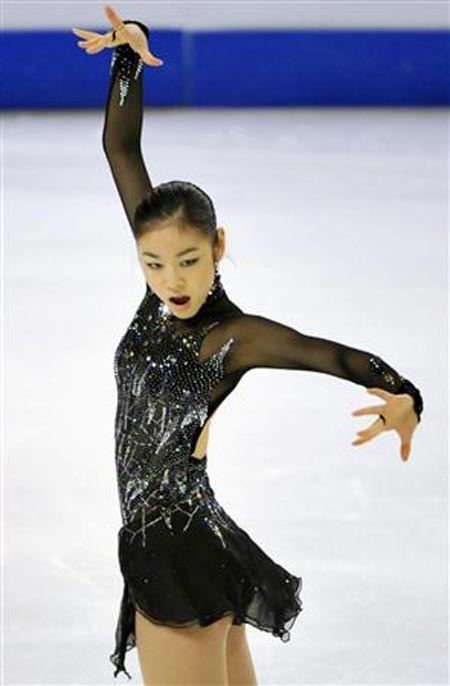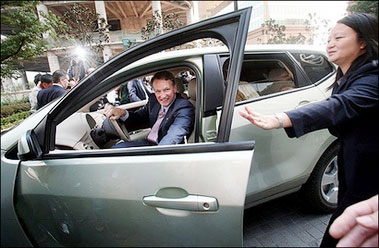
Sohn Kwang-joo, chief editor of Daily NK, in his office in Seoul. Jean Chung for the International Herald Tribune
Published: January 24, 2010
By CHOE SANG-HUN
SEOUL — For a journalist who helped break one of the biggest stories out of North Korea in the past year, Mun Seong-hwi keeps an extremely low profile. The name he offers is an alias. He does not reveal what he did in North Korea before his defection in 2006, aside from mention of a “desk job,” in order to protect relatives left behind.

Ha Tae-keung, president of Open Radio for North Korea, talked to a North Korean refugee stringer in China from his office in Seoul. Jean Chung for the International Herald Tribune
He also maintains a wall of secrecy around his three “underground stringers” in North Korea, who he says do not know he works for Daily NK, an Internet news service based in Seoul and reviled by Pyongyang.
On Nov. 30, quoting Mr. Mun’s and other anonymous “sources inside North Korea,” Daily NK reported that, starting that day, the North Korean government would radically devalue its currency, requiring people to exchange their old bank notes for new at a rate of 100 to 1. Furthermore, there would be limit on how much of this old money people could turn in for new.
The report, which made headlines around the world and was later confirmed by South Korean officials, had far-reaching implications. It meant, among other things, that the North Korean government was cracking down on the country’s nascent free markets, wiping out much of the wealth private entrepreneurs had accumulated by trading goods at a time when the Communist government’s ration system was failing to meet its people’s basic needs.
“I take pride in my work,” Mr. Mun, a man in his early 40s with brooding eyes and a receding hairline, said in an interview. “I help the outside world see North Korea as it is.”
Daily NK is one of six news outlets that have emerged in recent years specializing in collecting information from North Korea. These Web sites or newsletters hire North Korean defectors and cultivate sources inside a country shrouded in a near-total news blackout.
While North Korea shutters itself from the outside — it blocks the Internet, jams foreign radio broadcasts and monitors international calls — it releases propaganda-filled dispatches through the government’s mouthpiece, the Korean Central News Agency.
But, thanks to Daily NK and the other services, it is also possible now for outsiders to read a dizzying array of “heard-in-North Korea” reports, many on topics off limits for public discussion in the North, like the health of the country’s leader, Kim Jong-il.
The reports are sketchy at best, covering small pockets of North Korea society. Many prove wrong, contradict each other or remain unconfirmed. But they have also produced important scoops, like the currency devaluation and a recent outbreak of swine flu in North Korea. The mainstream media in South Korea now regularly quote these cottage-industry news services.
“Technology made this possible,” said Sohn Kwang-joo, the chief editor of Daily NK. “We infiltrate the wall of North Korea with cellphones.”
Over the past decade, the North’s border with China has grown more porous as famine drove many North Koreans out in search of food and an increasing traffic in goods — and information — developed. A new tribe of North Korean merchants negotiates smuggling deals with Chinese partners, using Chinese cellphones that pick up signals inside the North Korean border.
These phones have become a main tool of communication for many of the 17,000 North Korean defectors living in the South trying to re-establish contact with their families and friends in the North.
Mr. Sohn, a former reporter with the mainstream daily newspaper Dong-A in Seoul, has South Korean “correspondents” near the China-North Korea border.
These volunteers, many of them pro-democracy advocates during their student years, secretly meet North Koreans traveling across the border and recruit underground stringers. The volunteers use business visas, or sometimes pretend to be students or tourists.
“It’s dangerous work, and it takes one or two years to recruit one,” Mr. Sohn said.
In the past year, the quality of the information these news services provide has improved as they have hired more North Korean intellectuals and former officials who defected to the South and still have friends in elite circles in the North, said Ha Tae-keung, a former student activist who runs Open Radio for North Korea and a Web site.
“These officials provide news because they feel uncertain about the future of their regime and want to have a link with the outside world, or because of their friendship with the defectors working for us, or because of money,” said Mr. Ha, who also goes by his English name, Young Howard.
All these news outlets pay their informants. Mr. Ha pays a bonus for significant scoops. Daily NK and Open Radio each have 15 staff members, some of them defectors, and receive U.S. congressional funding through the National Endowment for Democracy, as well as support from other public and private sources.
Recently, they have been receiving tips from North Koreans about corrupt officials.
“The fact that news comes out through civic groups like ours means that North Korean society is changing fast,” said Pomnyun Sumin, a Buddhist monk and chairman of Good Friends, a relief group based in Seoul whose newsletter broke the swine flu story last month.
Some informants have become so adept with technology that they send text-messages, audio files and photos to Seoul by cell phone, said Kim Heung-gwang, a former North Korean computer scientist who heads North Korea Intellectuals Solidarity, a group of defectors that runs a news Web site.
Bringing news out of North Korea is risky. Mr. Kim said that one of his informants was stopped last May while trying to smuggle out a video in a small camera hidden in a cosmetics bottle. She is believed to have killed herself in police detention, he said.
“You wonder whether they should let their sources take such risks,” Chang Yong-hoon, who covers North Korea for the mainstream news agency Yonhap, said at a recent forum on the news services. “They’ve produced as many erroneous reports as they have real scoops.”
Kang Chol-hwan, a former North Korean prison camp inmate who now writes for the mainstream daily Chosun, said there are “information brokers” in North Korea who sell exaggerated and fake news to outside media. Lee Chan-ho, a chief analyst at the South Korean government’s Unification Ministry, warned that the “flood of raw, unconfirmed reports” complicates the effort to understand the North.
Mr. Ha, of Open Radio for North Korea, conceded that point: “Because our sources have never been trained in journalism, exaggeration is a problem for us. Some demand more money for information. We try to cross-check our reports as much as possible.”
Mr. Mun of Daily NK sends his stringers 1,000 Chinese renminbi, or about $150, every two or three months. They call him once a week at a designated time. They find a place where they feel safe from the North Korean police patrolling with equipment that detects cell phone users, and dial. In Seoul, Mr. Mun hears the ring tone, then calls back and talks for about half an hour. After the call, his stringers hang up and hide their phones until the next call.
Recently, with so many developments in the North, they have been calling him at unscheduled times, for instance, when he was in the subway.
“I have to rush off and call back quickly,” Mr. Mun said. “If I don’t within five minutes, he’ll turn off and I’ll lose him.”
There is another strict rule.
“We don’t know, and never ask, each other’s real name,” Mr. Mun said. “That’s safer for them. Their safety is my biggest concern.”
A version of this article appeared in print on January 25, 2010, in The International Herald Tribune.





 Page last updated at 03:43 GMT, Tuesday, 26 January 2010
Page last updated at 03:43 GMT, Tuesday, 26 January 2010



 Voters in the small Okinawan town of Nago have elected a mayor who opposes the relocation of the U.S. Marine Corps Air Station Futenma (shown here in November 2009) from Ginowan, Okinawa Prefecture, to Nago. Kazuhiro Nogi/AFP/Getty Images
Voters in the small Okinawan town of Nago have elected a mayor who opposes the relocation of the U.S. Marine Corps Air Station Futenma (shown here in November 2009) from Ginowan, Okinawa Prefecture, to Nago. Kazuhiro Nogi/AFP/Getty Images Tuesday, January 26, 2010
Tuesday, January 26, 2010  2010-01-25 19:40:37
2010-01-25 19:40:37 
 Published: January 25, 2010
Published: January 25, 2010 
 2010/01/26 09:17 KST
2010/01/26 09:17 KST Reigning world champion Kim Yu-na is favored to win gold in the women's figure skating event.
Reigning world champion Kim Yu-na is favored to win gold in the women's figure skating event.  Lee Kang-seok and Lee Kyou-hyuk are in peak condition after undertaking six World Cup series competitions. As they hold first and second in the men's 500 meter World Cup rankings, their sprint races in Vancouver will be another rich vein of gold at the upcoming Olympics.
Lee Kang-seok and Lee Kyou-hyuk are in peak condition after undertaking six World Cup series competitions. As they hold first and second in the men's 500 meter World Cup rankings, their sprint races in Vancouver will be another rich vein of gold at the upcoming Olympics.  Notably, the bobsled team piloted by four-time Olympian Kang Kwang-bae will compete in both four-man and two-man events for the first time in the country's winter sports history.
Notably, the bobsled team piloted by four-time Olympian Kang Kwang-bae will compete in both four-man and two-man events for the first time in the country's winter sports history. 


 24 Jan 2010, 1417 hrs IST, REUTERS
24 Jan 2010, 1417 hrs IST, REUTERS




